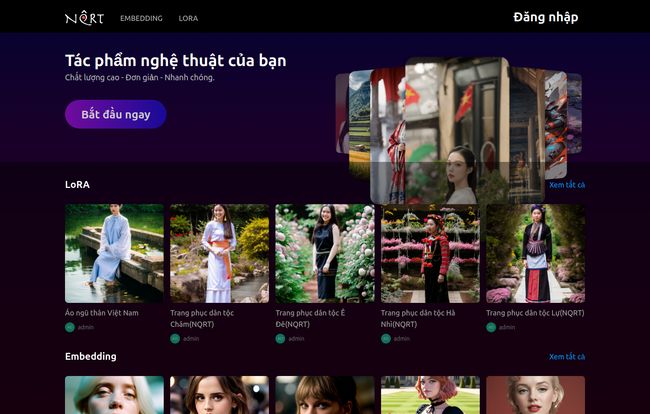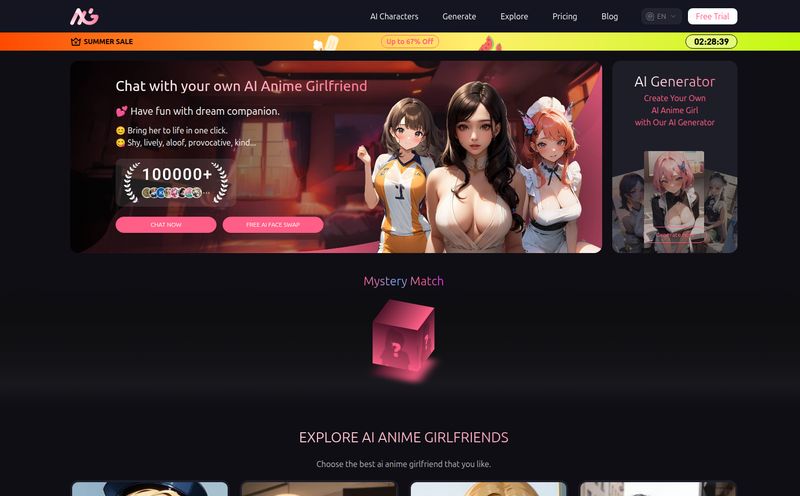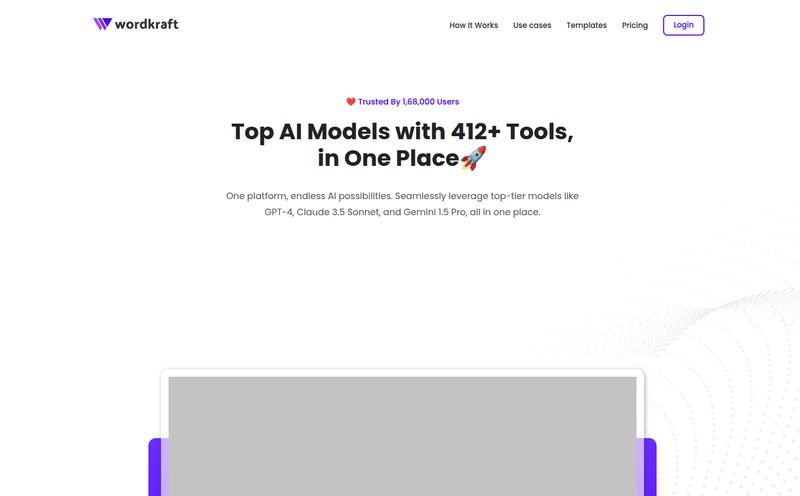The world of AI art generators has completely exploded. It feels like every week there’s a new tool on the block, each promising to be the one that finally turns your half-baked ideas into digital masterpieces. As someone who’s spent more hours than I’d like to admit tinkering with prompts in Midjourney and wrestling with local Stable Diffusion installs, I've seen it all. The good, the bad, and the ones that just spit out images of people with seven fingers.
So when I stumbled across NQRT, my first reaction was a mix of skepticism and curiosity. The homepage was clean, almost minimalist, plastered with some seriously impressive images. But something else stood out: the text was a mix of English and Vietnamese. Intriguing. It promised simplicity, quality, and speed. A classic trifecta. But does it deliver? I decided to take a closer look.
What Exactly is NQRT?
At its heart, NQRT is a generative AI platform designed to be as straightforward as possible. Think of it as the point-and-shoot camera in a world of complex DSLRs. The big idea is to let you create artwork with just one click, without needing a PhD in prompt engineering. And honestly, that's a breath of fresh air.
But the feature that really grabbed me is its claim to support all languages. This isn’t just a nice-to-have; it's a huge step toward making this tech accessible to everyone, not just English speakers. It’s a tool that feels like it was built with a global audience in mind from day one, which I’ve got to respect.
First Impressions and Getting Started
Landing on the NQRT site feels less like loading up a piece of software and more like walking into a digital art gallery. The page is dominated by examples of what it can do—gorgeous portraits, slick car renders, vibrant anime scenes, and even a mouth-watering picture of a Bánh mì. It immediately shows you the potential before you even type a single word.
You’re greeted with a big purple button that says “Bắt đầu ngay” (which my trusty translator tells me means “Start now”). The footer proudly states “Make in Vietnam.” This isn't your typical Silicon Valley startup, and I find that pretty cool. It has a distinct identity. The interface itself is uncluttered, focusing your attention on the creation process rather than overwhelming you with a dozen sliders and checkboxes.

Visit NQRT
The Standout Features That Caught My Eye
Beyond the simple interface, NQRT is packing some surprisingly powerful features under the hood. It’s not just for churning out random images; there’s some real depth here for those who want to customize their creations.
LoRA and Embedding Support for Powerful Customization
Okay, for the non-techies, let's break this down. Seeing LoRA and Embedding support on a tool this user-friendly is a big deal. Think of LoRAs (Low-Rank Adaptation) as special training files that teach the AI a very specific style or character. Want to generate images that look like they're from your favorite obscure indie comic? A LoRA can do that. The examples on the site, like the ones for specific Vietnamese traditional dresses (Áo dài), are perfect demonstrations of this power.
Embeddings are similar, often used to teach the AI a specific concept, like a person's face. The gallery showcasing eerily accurate depictions of celebrities like Emma Watson and Taylor Swift? That’s the magic of embeddings at work. Including these features means NQRT isn't just a toy; it’s a legitimate creative tool for artists and hobbyists who want consistent, personalized results. It’s like having your own little specialized artist on call.
Truly Multilingual AI Image Prompts
I have to come back to this because I think it’s NQRT’s killer feature. For so long, the creative AI space has operated with an unspoken rule: you need to be decent at English to write good prompts. This has put a massive barrier up for millions of creative people around the world. NQRT kicks that door down. The ability to just type a description in your native tongue—be it Spanish, Hindi, or Vietnamese—and get a high-quality image is revolutionary. It’s lowering the velvet rope and inviting everyone to the party, and the creative world will be richer for it.
Speed and Quality, The Golden Duo
NQRT claims to be fast and produce high-quality images. In my experience, you usually have to pick one. Fast generators often produce muddy, incoherent results, while high-quality models can take minutes to render a single image. While I haven't run extensive benchmarks myself, the gallery on their site is a testament to the quality they're aiming for. The images are sharp, coherent, and artistically compelling. If they can deliver this level of quality with the speed they promise, they’ve solved a major pain point for many creators.
So, Who Is NQRT Actually For?
After playing around with it, I have a pretty clear picture of who would love NQRT. It’s perfect for the absolute beginner who is curious about AI art but gets anxiety just looking at the settings panel in other tools. It’s also a game-changer for the international artist or hobbyist who’s tired of running all their ideas through Google Translate before prompting.
I also see a spot for the intermediate user—someone who understands concepts like LoRA but doesn't want the headache of managing a local install with all its dependencies and command-line nightmares. This platform gives you the power without the pain. It might not be for the hardcore programmer who wants to tweak the sampler schedule and CFG scale for every single generation, but for everyone else? It hits a real sweet spot.
The Not-So-Great Stuff
No tool is perfect, right? There are a couple of things that give me pause. First, the elephant in the room: pricing. As of writing this, there's no clear pricing page or information available. Is it free? Is it a credit-based system? Will it be a subscription? This lack of transparency is a bit of a hurdle. I'm hoping it's just because the tool is new and they're still figuring it out.
The other small quibble is the one I noticed right away—the mixed-language website. While I personally find its international flavor charming, I can see how it might be confusing or come off as a bit unpolished to some users. It creates a tiny bit of friction. Lastly, for the real tech nerds, there's no information on the specific AI models being used. While most users just care about the results, some of us like to know what's going on behind the curtain.
My Final Verdict on NQRT
So, what’s the bottom line? I’m genuinely impressed. NQRT has entered a very crowded market with a clear and compelling vision: to make AI art generation simple, fast, and accessible to everyone, regardless of what language they speak. It successfully combines the ease of a one-click generator with advanced features like LoRA support that give it surprising depth.
Is it perfect? Not yet. The lack of pricing info and minor website inconsistencies are things to be aware of. But these feel like growing pains, not fundamental flaws. For anyone who has felt intimidated by other AI art tools, or for creators who want to prompt in their native language, I’d say NQRT is not just worth a look—it’s a must-try. It’s a fantastic example of how technology can become more inclusive and, in the process, more creative.
Frequently Asked Questions about NQRT
- What is NQRT?
- NQRT is an AI-powered platform for creating images and artwork from text descriptions. Its main focus is on simplicity, speed, and supporting users from all language backgrounds.
- Does NQRT support languages other than English?
- Yes, and this is one of its biggest strengths. NQRT is designed to accept prompts in any language, making it highly accessible for non-English speakers.
- What is LoRA and why is it important in NQRT?
- LoRA is a technique that allows for fine-tuning the AI model to create specific, consistent styles or characters. NQRT's support for LoRA means users can go beyond generic images and create highly personalized and unique artwork.
- How much does NQRT cost?
- Currently, there is no public information available on NQRT's pricing model. It may be in a free beta phase or using a credit system upon sign-up.
- Is NQRT good for beginners?
- Absolutely. It's one of the most beginner-friendly AI art tools available, thanks to its one-click generation and simple interface. It removes much of the technical complexity found in other platforms.
- What kind of images can I create with NQRT?
- You can create a huge variety of images, including photorealistic portraits, anime and cartoon characters, fantasy landscapes, architectural designs, abstract art, and much more. The platform's support for different styles, LoRAs, and embeddings allows for a wide range of creative output.
Conclusion
In a sea of AI tools that all start to look the same, NQRT brings something different to the table. It’s a powerful reminder that the best technology is the kind that empowers more people to create. By breaking down the language barrier and simplifying the creative process, it’s not just generating images; it’s generating possibilities. Go give it a spin and see what your imagination comes up with. You might be surprised.



